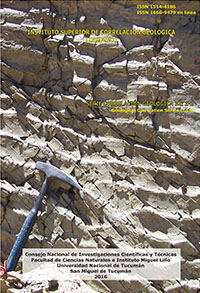Serie Correlación Geológica 32
Caracterización sedimentológica y edades de los depósitos lacustres Pleistocenos – Holocenos del Noroeste de Santa Cruz, Argentina.
Luis R. Horta | Sergio M. Georgieff
Descargar trabajo en formato PDFResumen
CARACTERIZACIÓN SEDIMENTOLÓGICA Y EDADES DE LOS DEPÓSITOS LACUSTRES PLEISTOCENOS – HOLOCENOS DEL NOROESTE DE SANTA CRUZ, ARGENTINA. Este trabajo compara las características sedimentológicas y las edades radiométricas de los depósitos del Pleistoceno Tardío y del Holoceno que rodean al Sistema Lacustre Pueyrredón - Posadas - Salitroso (SL – PPS, NW de la provincia de Santa Cruz, Argentina). Seis perfiles estratigráficos fueron descriptos y muestreados para estudiar la evolución del SL-PPS. Además, la materia orgánica procedente de los sedimentos finos fue datada utilizando los métodos AMS y 14C. En 14 muestras de arcillas, limos y arenas (ubicadas a diferentes alturas, 400, 300 y 200 msnm) se realizaron análisis granulométricos, que permitieron distinguir zonas subaéreas, subácueas (someras y profundas) de la cuenca. El análisis de tamaños de granos integrado con las asociaciones de facies indica tanto los paleoambientes sedimentarios (lacustres, glaciolacúsicos o litorales) como la relación entre los cuerpos sedimentarios; además, de identificar las fluctuaciones de los paleolagos. En general, el arreglo granocreciente en el SL-PPS se interpreta como ciclos lacustres somerizantes relacionados a la caída regional de los lagos de nivel básico en dirección Este-Oeste desde el Pleistoceno Tardío (ca. 25.000 años BP) hasta el Holoceno.
Abstract
SEDIMENTOLOGICAL CHARACTERIZATION AND AGES OF THE PLEISTOCENE - HOLOCENE LACUSTRINE DEPOSITS NORTHWEST SANTA CRUZ, ARGENTINA. This paper compares sedimentological characteristics and radiometric ages of the Late Pleistocene and Holocene deposits cropping out surrounding to Pueyrredón - Posadas – Salitroso Lacustrine System (PPS-LS, NW of Santa Cruz province, Argentina). Six detailed stratigraphic profiles were measured and sampled in order to understand the PPS-LS evolution. The organic matter of fine sediments was dated using the AMS & 14C methods. In fourteen samples of clays, silts, and sands (located at different heights, 400, 300 and 200 masl) were realized grain size analysis, which allowing distinguish between subaerial and subaqueous (shallow and deep) areas in the basin. The grain sizes analysis integrated with facies associations indicate as sedimentary paleoenvironments (lacustrine, glaciolacustrine or coast lake) as the linkage among sedimentary bodies and also identify the paleolake fluctuations. In general, coarsening-upward variations in PPS-LS are interpreted as shallowing lake cycles related to the regional fall of baselevel lakes in East - West direction from Late Pleistocene (ca. 25,000 yrs. BP) to Holocene.






